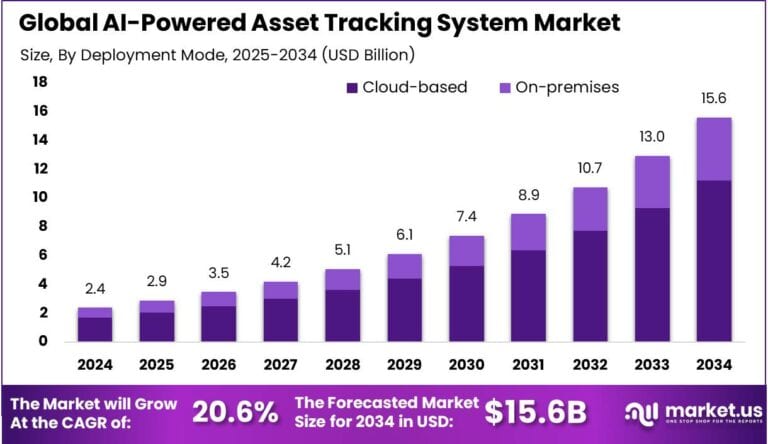Table of Contents
The AI-Powered Asset Tracking System Market is projected to grow from USD 2.4 billion in 2024 to USD 15.6 billion by 2034, exhibiting a strong CAGR of 20.60% during 2025-2034. This rapid growth is driven by increasing demand for intelligent, real-time asset management solutions across industries such as logistics, manufacturing, and healthcare. In 2024, North America led the market with a 34% share and revenue of USD 0.8 billion, with the U.S. contributing USD 0.7 billion and expected to grow at 18.2% CAGR due to advancements in AI and IoT technologies.

How Tariffs Are Impacting the Economy
Tariffs on imported components essential to AI-powered asset tracking systems—such as sensors, RFID tags, IoT devices, and computing hardware—have increased costs for manufacturers and end-users. The U.S. tariffs on technology imports, especially from Asia, have led to higher prices and procurement delays.
➤ Discover how our research uncovers business opportunities @ https://market.us/report/ai-powered-asset-tracking-system-market/free-sample/
(Use corporate mail ID for quicker response)
These tariffs disrupt supply chains, forcing companies to reconsider sourcing strategies, which may result in production slowdowns and increased lead times. Higher component costs elevate project budgets, potentially slowing down adoption rates of AI tracking solutions. Despite the intent to protect domestic industries, tariffs introduce inflationary pressures and uncertainties, affecting the pace of digital transformation in asset management sectors.

Impact on Global Businesses
Global businesses providing AI-powered asset tracking solutions face rising hardware and software costs due to tariffs, impacting profitability and investment capacity. Logistics, manufacturing, and healthcare sectors experience delays and cost pressures affecting supply chain visibility and operational efficiency. Some companies are shifting to regional suppliers or increasing local manufacturing to mitigate tariff impacts. Cloud-based asset tracking solutions gain popularity as they reduce hardware dependency. Firms adapting supply chains and embracing digital innovation maintain competitiveness despite trade challenges.
Strategies for Businesses
Businesses are:
- Diversifying supply chains to reduce tariff exposure
- Investing in local manufacturing and assembly
- Adopting cloud and SaaS-based asset tracking solutions
- Enhancing supply chain transparency with digital tools
- Engaging policymakers for tariff relief and trade facilitation
These strategies support growth and operational continuity amid tariff pressures.
Key Takeaways
- Market to grow at 20.60% CAGR through 2034
- Tariffs increase component costs and disrupt supply chains
- Local sourcing and supplier diversification reduce risks
- Cloud-based solutions help mitigate hardware reliance
- Policy advocacy crucial for tariff mitigation
➤ Get full access now @ https://market.us/purchase-report/?report_id=148703
Analyst Viewpoint
Despite tariff-driven cost challenges, the AI-powered asset tracking market shows robust growth, fueled by the demand for real-time asset visibility and automation. Companies leveraging cloud technologies and flexible supply chains are better positioned. Emerging AI and IoT innovations will drive further expansion. Stabilizing trade policies will ease disruptions. Overall, the outlook is positive as industries digitize asset management.
Regional Analysis
North America leads with over 34% market share, driven by advanced infrastructure and early technology adoption. Europe follows, propelled by strong logistics and manufacturing sectors. Asia-Pacific exhibits rapid growth due to expanding industrialization, e-commerce, and smart city projects in China, India, and Japan. Latin America and the Middle East are emerging markets investing in asset tracking modernization.
➤ Discover More Trending Research
- Tax Tech Market
- Predictive Agents Market
- Smart Asset Management in Utility Market
- Task Management Agent Market
Business Opportunities
Opportunities abound in AI-driven inventory management, predictive maintenance, and real-time tracking across logistics, manufacturing, healthcare, and retail. The surge in IoT devices boosts demand for integrated tracking solutions. Cloud platforms enable scalable deployment for enterprises of all sizes. Expansion into emerging economies with rising supply chain complexities offers significant growth potential.
Key Segmentation
Segments include:
By Component
- Hardware (sensors, RFID, GPS)
- Software (tracking platforms, analytics)
- Services (integration, consulting, support)
By Deployment
- Cloud-based
- On-premise
By End-User Industry
- Logistics & Transportation
- Manufacturing
- Healthcare
- Retail
By Region
- North America
- Europe
- Asia-Pacific
- Latin America
- Middle East & Africa
Each segment has distinct drivers based on technology adoption and sector requirements.
Key Player Analysis
Leading players focus on AI and IoT integration to provide accurate, scalable tracking solutions. Strategic partnerships with cloud providers and hardware manufacturers enhance offerings. Investments emphasize innovation in predictive analytics, real-time monitoring, and user-friendly platforms. Compliance with data security and privacy regulations is prioritized. Differentiation arises from advanced technology, customization, and comprehensive customer support.
Recent Developments
In 2024, several providers launched AI-enhanced asset tracking platforms with improved predictive capabilities and expanded cloud integration, facilitating real-time decision-making and operational efficiency.
Conclusion
The AI-powered asset tracking system market is set for strong growth driven by digital transformation and demand for real-time asset visibility. Firms focusing on supply chain resilience, cloud adoption, and AI innovation will capture emerging opportunities despite tariff challenges.
Discuss your needs with our analyst
Please share your requirements with more details so our analyst can check if they can solve your problem(s)



